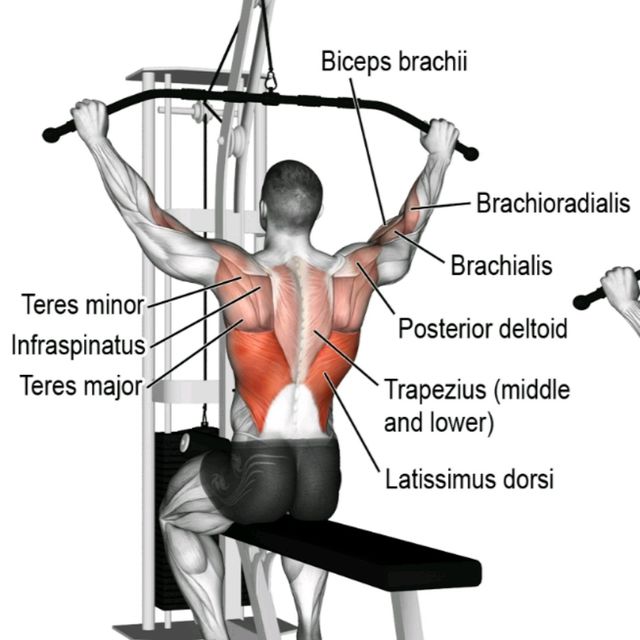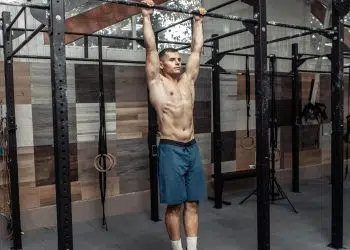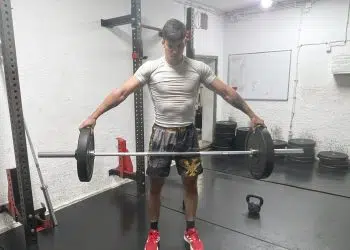A lot of bodybuilders are guilty of paying too much attention to the muscles on the front of their body – the muscles they can see in the mirror. So, while things like your pecs, biceps, abs, and quads ARE important, you must not neglect the muscles that aren’t so easy to see, i.e., those on the back of your body.
Muscles are arranged in opposing pairs, and for optimal function and appearance, both the muscles in each pair should be roughly the same strength and size. That means your quads and hamstrings, biceps and triceps, and anterior and posterior deltoids should receive equal attention during your workouts.
This all means that you need to make sure you train your back as much as your chest.
There are plenty of back exercises to choose from, but one of the most popular and best is the pronated pulldown.
Make sure you’re doing this exercise correctly, so you get the best possible results from each and every set and rep you perform!
Pronated – Muscles Worked
Pronated pulldowns are a compound exercise. That means they involves multiple muscles and joints working together. The main muscles involved in pronated pulldowns are:
Level Up Your Fitness: Join our 💪 strong community in Fitness Volt Newsletter. Get daily inspiration, expert-backed workouts, nutrition tips, the latest in strength sports, and the support you need to reach your goals. Subscribe for free!
Latissimus dorsi – the largest muscle of the upper back, the lats adduct and extend your shoulder joint. When well-developed, the lats look like wings as they spread out from under your armpits. Pronated pulldowns tend to make your lats wider.
Teres major – teres major is a thick muscle that runs from the lateral edge of your scapula or shoulder blade to your humerus or upper arm bone. It works with your lats and is responsible for the following joint actions:
- Adduction of the shoulder joint
- Extension of the shoulder joint
- Medial rotation of the shoulder joint
- Stabilization of the shoulder joint
Biceps brachii – arguably the most famous muscle in the human body, the biceps are located at the front of your upper arm and are responsible for elbow flexion and forearm supination. They are also a weak flexor of the shoulder joint. While pronated lat pulldowns are undeniably a lat exercise, your biceps will also get a good workout.
Posterior deltoid – located on the back of your shoulder, the posterior deltoid works with your lats to extend your shoulder to the rear.
Trapezius – this large diamond-shaped muscle is located between and across your shoulder blades. There are three sets of fibers: lower, middle, and upper. The lower fibers of the trapezius pull your shoulders down while the middle fibers pull them back and together. The upper traps, which are responsible for elevation your shoulders, are not very active during pronated pulldowns.
How to Do Pronated Pulldowns
Get more from pronated pulldowns while keeping your risk of injury to a minimum by following these guidelines:
- Adjust the weight and then hold the bar with an overhand, slightly wider than shoulder-width grip. Wrap your fingers and thumbs around the bar for a secure grip. You can also use a wider grip if preferred, i.e., outside of shoulder-width apart.
- Sit down, so your thighs are held in place by the leg restraints. Pull your shoulders down and back and lean back slightly, lifting your chest up toward the bar.
- Keeping your wrists straight, lead with your elbows and bend your arms, pulling the bar down to your upper chest.
- Pause in this most contracted position and then smoothly return to the start.
- Without relaxing your shoulders, repeat for the desired number of repetitions.
- Do not lean your upper body back while doing pronated pulldowns. Doing so turns what should be a vertical pulling exercise into a semi-horizontal exercise, making it more like a row.
Pronated Pulldown Benefits and Drawbacks
Not sure if pronated pulldowns deserve a place in your workouts? Consider these benefits and then decide!
Suitable for all levels of exerciser – lat pulldown machines have a selectorized weight stack, making it easy to change the weights. It doesn’t matter how strong (or how weak) you are; you should be able to do this exercise. In contrast, some bodyweight exercises are simply too hard for many beginners.
Easy to learn – lat pulldowns are a pretty straightforward exercise, and even training novices should be able to pick them up quickly. While it can be gratifying to learn a new exercise, it’s also nice to be able to get to grips with a new movement after just a few minutes.
Minimal lower back stress – when it comes to lat exercises, there are two main movement patterns; horizontal pulls (rows) and vertical pulls (pull-ups and pulldowns). Many rowing exercises involve leaning forward at the waist, which can put a lot of stress on your lower back.
For some exercisers, this stress is a problem. Pronated pulldowns place very little pressure on your lower back and can even help stretch and decompress your spine. In short, lat pulldowns are a very lower back-friendly exercise.
Perfect for drop sets – take your back development to a new level by incorporating drop sets into your workouts. Drop sets are a training system where you reduce the weight as you near fatigue. This allows you to train beyond muscular failure, triggering greater muscle growth. Pronated pulldowns are PERFECT for drop sets.
To do a drop set, rep out as normal until you reach failure. Reduce the weight by 10-15% and then immediately rep out again. Drop the weight 2-4 times to hammer every available muscle fiber and trigger maximum hypertrophy.
While pronated pulldowns are a mostly beneficial exercise, there are also a few drawbacks to consider:
Limited availability – while most gyms have lat pulldown machines, you may not have access to a lat pulldown machine if you work out at home or in a garage gym. They tend to be big and quite expensive, so even if you want one for your home gym, it may not be practical to get one. That said, it IS possible to do lat pulldowns using a resistance band – see exercise #10.
Weight limit – train long enough and build enough strength, and you may outgrow pronated pulldowns, especially if the machine you use only has a small weight stack. Once you can rep out the entire stack of weights on your pulldown machine, this exercise loses some of its potency, and you’ll have no choice but to do more reps to continue challenging your muscles.
10 Pronated Pulldown Alternatives
Pronated pulldowns are a highly effective upper body exercise, but that doesn’t mean you need to do them all the time. There are several variations and alternatives you can use to keep your workouts productive and interesting:
1. Reverse grip lat pulldown
Pronated or overhand pulldowns place your biceps in a slightly compromised position, which means they may fail before your bigger, stronger lats. Switching to a reverse or supinated grip may mean you can pump out more reps or use a heavier weight, working your lats harder in the process. However, some people find that this variation leads to more elbow and biceps tendon stress.
Learn how to do reverse grip lat pulldowns here.
2. Close neutral grip pulldowns
Neutral pulldowns involve positioning your hands so that your palms face inward. This grip is very comfortable and puts very little stress on the elbows. Doing pulldowns with a narrow, neutral grip tends to emphasize the center of your upper back.
A neutral grip is a strong grip, so don’t be surprised if you can use more weight or do more reps compared to the overhand or pronated version.
Level Up Your Fitness: Join our 💪 strong community in Fitness Volt Newsletter. Get daily inspiration, expert-backed workouts, nutrition tips, the latest in strength sports, and the support you need to reach your goals. Subscribe for free!
Find out more about this exercise here.
3. Pull-ups
No lat pulldown machine? No problem! You can work all the same muscles using nothing but your body weight by doing pull-ups instead. Like pronated pulldowns, pull-ups are done using an overhand grip. However, you can also do supinated (underhand) chin-ups or use a neutral grip.
On the downside, to do pull-ups, you need to be strong enough to lift your body weight using just your arms. As such, pull-ups may be too demanding for some exercisers.
Learn how to get better at pull-ups here.
4. Australian pull-ups
Australian pull-ups, also known as body rows and incline rows, work the same muscles as pronated pulldowns and pull-ups. However, unlike pull-ups that involve lifting your entire body weight, with this exercise your feet stay on the floor, making them considerably more manageable.
All you need to do this exercise is a waist-high bar or a suspension trainer attached to a solid overhead anchor.
Read more about Austrian pull-ups here.
5. Straight arm pulldowns
Pronated pulldowns work your biceps almost as much as your lats. In contrast, straight arm pulldowns minimize arm involvement, so you’re left free to generate all the tension with your back muscles. You can do this exercise using a regular lat pulldown machine or if you prefer, one side of a cable crossover machine.
Learn how to do this exercise here.
6. Seal rows
Seal rows, also known as chest supported and incline rows, can be done with a barbell or dumbbells. Like pronated pulldowns, this exercise is very lower back-friendly and works your lats, biceps, and middle trapezius/rhomboids. It’s a low-tech exercise and ideal for anyone without a lat pulldown machine and who cannot do pull-ups.
Find out more about seal rows here.
7. Dumbbell pullover
While we’re the first to admit that the dumbbell pullover looks nothing like a pronated pulldown, don’t let that put you off this great exercise. The dumbbell pullover works your lats like straight arm pulldowns, and, like that exercise, it doesn’t involve your biceps, so you’re free to focus on working your lats.
Dumbbell pullovers used to be something of a golden-era bodybuilding staple but are less common nowadays. Still, it’s a good exercise and a decent alternative to pulldowns, especially when you’re looking for a freeweight move to do in place of a machine.
Learn more about dumbbell pullovers here.
8. Single-arm dumbbell row
The single-arm dumbbell row is a very lower-back-friendly lat exercise. Granted, it’s a horizontal row rather than a vertical row, but it still works the same muscles as the pronated pulldown.
Working one arm at a time means you’ve got one arm free to support your lower back and allows you to train both sides of your back independently, so you can make sure they’re equally well developed.
Read all about single-arm dumbbell rows here.
9. Single-arm lat pulldown
The basic lat pulldown is a bilateral exercise, which means it works your left and right arm simultaneously. There is nothing wrong with this, but, for variety, it’s sometimes helpful to train one side at a time – a unilateral exercise.
To do single-arm lat pulldowns, simply replace your usual bar with a D-shaped handle. Not only can you work one side of your lats at a time, but you can also rotate your wrist as you train, which can help take the stress off your elbow joint and may prevent elbow pain. You may also find that this exercise allows for a stronger mind-muscle connection.
How to do it:
- Attach a single D-shaped handle to the lat pulldown machine. Grip the handle in one hand and sit down.
- Keeping your torso upright, bend your arm, and, leading with your elbow, pull the handle down to the front of your shoulder. Allow your wrist to rotate naturally or use a pronated, supinated, or neutral hand position as preferred.
- Extend your arm and repeat.
- Do the same number of reps on both sides.
10. Resistance Band Lat Pulldowns
You can also perform the lat pulldown using resistance bands. All you need is a suitable anchor point and a good set of resistance bands.
You’ll need to fix your band overhead, but that’s easy to do. Just loop it over a roof joist or tree branch or tie a knot in your band and shut it in a door. You can also buy special anchors that you can bolt to your ceiling.
However you do them, resistance band lat pulldowns are perfect for home exercisers and, if you take your bands with you, are ideal for travelers, too.
Pronated Pulldown – Wrapping Up
The pronated pulldown is a pretty well-known and commonly performed exercise. It’s a staple of many people’s workouts, and it’s popular because it works. Bodybuilders use it to build a bigger, wider back, while general exercisers perform them as an alternative to and a way to develop the strength necessary for pull-ups.
But, to get the most from this exercise, you must do it right. That means lifting your chest, leading with your elbows, and pulling the bar to your upper chest. Don’t try and push the bar forward and down. Instead, squeeze your shoulders down and back.
Do that, and you’ll not only get better results, but you’ll significantly reduce your risk of injury.
Interested in measuring your progress? Check out our strength standards for Dumbbell Pullover, Pull Ups, Dumbbell Row, and more.









